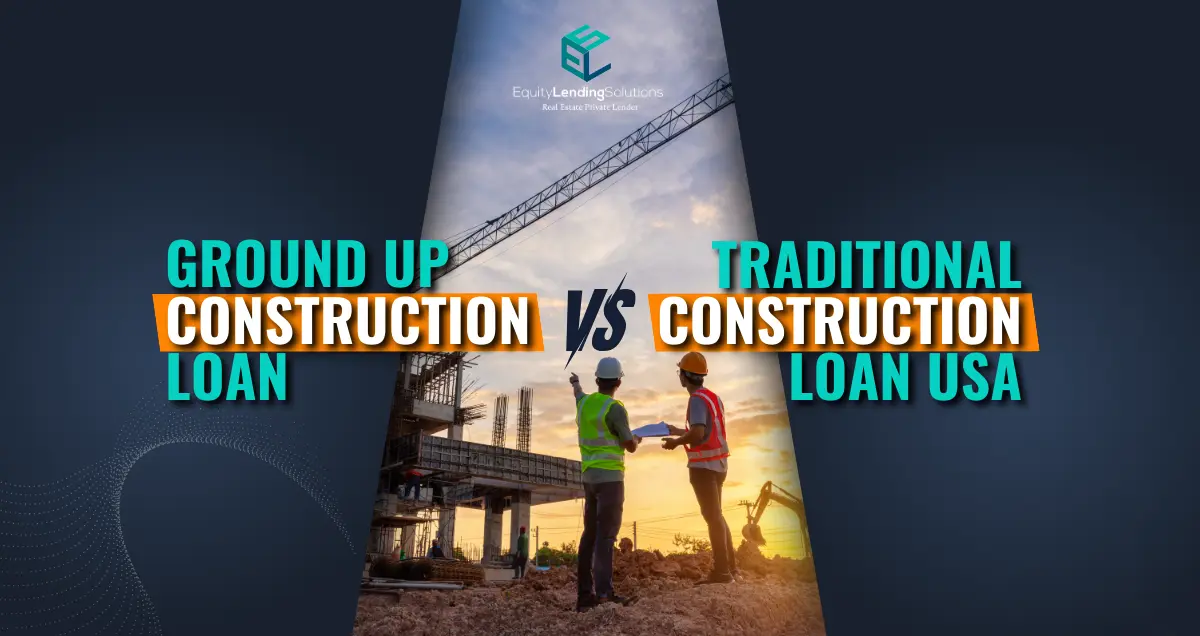When it comes to financing construction projects, there are multiple loan options available. Two popular choices are Ground Up Construction Loans and Traditional Construction Loans. Both loans finance the construction of buildings, but they differ in structure, eligibility, and benefits. This article will explore the differences between Ground Up Construction Loans and Traditional Construction Loans in the USA, providing the necessary information to make an informed decision for your next project.
What is a Ground Up Construction Loan?
Definition and Purpose
A Ground Up Construction Loan is specifically designed to finance the construction of a new building from scratch. This type of loan covers everything from land acquisition to the final stages of construction. It is suitable for projects that involve building entirely new structures, whether residential, commercial, or industrial.
Key Features
Comprehensive Coverage
Ground Up Construction Loans provide comprehensive coverage for all construction-related expenses. This includes purchasing the land, site preparation, materials, labor, and other associated costs.
Flexible Disbursement
The loan is typically disbursed in stages, aligned with the progress of the construction. This means funds are released at different milestones, ensuring the project stays on track financially.
Interest Rates and Terms
Interest rates for Ground Up Construction Loans can vary based on the lender, loan amount, and borrower’s creditworthiness. Generally, these loans may have higher interest rates than traditional ones due to the higher risk involved.
What is a Traditional Construction Loan?
Definition and Purpose
Traditional Construction Loans are designed to finance the building or renovation of a property with a structure. These loans suit projects involving significant renovations, additions, or completions of partially built structures.
Key Features
Specific Project Focus
Traditional Construction Loans are focused on projects where a structure already exists. This could involve extensive renovations, expansions, or completing an unfinished building.
Structured Disbursement
Similar to Ground Up Construction Loans, Traditional Construction Loans are also disbursed in stages. However, the stages are often more rigidly structured around pre-set construction milestones.
Interest Rates and Terms
Interest rates for Traditional Construction Loans are generally lower than those for Ground Up Construction Loans, reflecting the reduced risk associated with having an existing structure.
Differences Between Ground-Up Construction Loans and Traditional Construction Loans
Eligibility Criteria
Ground Up Construction Loans
Eligibility for Ground Up Construction Loans often requires a detailed project plan, including architectural designs, construction timelines, and cost estimates. Lenders will also assess the borrower’s credit history, financial stability, and experience in managing construction projects.
Traditional Construction Loans
Traditional Construction Loans may have slightly less stringent eligibility criteria, focusing more on the value of the existing property and the proposed improvements. However, borrowers still need to present a solid project plan and demonstrate their ability to complete the project.
Loan Amount and Disbursement
Ground Up Construction Loans
The loan amount for Ground Up Construction Loans tends to be higher due to the comprehensive nature of the financing. Funds are disbursed in phases, typically at key stages such as land purchase, foundation laying, framing, and final completion.
Traditional Construction Loans
Loan amounts for Traditional Construction Loans are generally lower, as they focus on specific improvements rather than a full build. Disbursement is also phased but often aligned more closely with specific renovation milestones.
Risk and Security
Ground Up Construction Loans
These loans carry a higher risk for lenders because they finance a project starting from zero. As a result, interest rates are often higher, and lenders may require additional security or guarantees.
Traditional Construction Loans
With an existing structure in place, the risk is somewhat reduced for Traditional Construction Loans. This often results in lower interest rates and less stringent security requirements.
Choosing the Right Loan for Your Project
When to Choose a Ground-Up Construction Loan
Opt for a Ground Up Construction Loan if you are starting a project from scratch, need comprehensive financing, and are prepared for a more involved approval process. This loan is ideal for large-scale projects, including new residential communities, commercial buildings, or industrial facilities.
When to Choose a Traditional Construction Loan
A Traditional Construction Loan is suitable if you are working on an existing property, whether for extensive renovations, expansions or completing an unfinished structure. These loans are more accessible in terms of eligibility and are generally faster to secure.
Application Process and Tips
Ground Up Construction Loan Application
- Prepare a Detailed Plan: Include architectural designs, project timelines, and cost estimates.
- Financial Documentation: Provide proof of financial stability, credit history, and any prior construction experience.
- Choose the Right Lender: Research and select a lender experienced in ground-up construction financing.
- Submit Your Application: Complete the lender’s application process, ensuring all required documents are included.
- Approval and Disbursement: Upon approval, funds will be disbursed in stages according to the construction progress.
Traditional Construction Loan Application
- Project Overview: Outline the scope of renovations or additions, including cost estimates.
- Property Appraisal: Have the existing property appraised to determine its current value.
- Financial Documentation: Similar to ground-up loans, provide necessary financial documents.
- Lender Selection: Choose a lender with expertise in traditional construction loans.
- Submit and Wait: Submit your application and await approval. Funds will be released as per the agreed milestones.
Understanding the differences between Ground Up Construction Loans and Traditional Construction Loans is crucial for selecting the right financing for your construction project. Each loan type has its unique advantages and is suited to different project requirements.
If you’re ready to take the next step in your construction journey, consider applying for a loan with Equity Lending Solutions. They offer tailored financing options to meet your specific needs and ensure the success of your project.
Ready to start your construction project? Apply now with Equity Lending Solutions for a loan that fits your needs perfectly!
Article sources:
- Investopedia. (n.d.). Ground Up Construction Loans. Retrieved May 15, 2024, from https://www.investopedia.com/terms/g/ground-up-construction-loan.asp
- Block, S. (2023). Traditional Construction Loans vs. Ground-Up Construction Loans. The Balance. Retrieved May 15, 2024, from https://www.thebalance.com/construction-loan-what-you-need-to-know-5190273
- McCarthy, N. (2023). How Construction Loans Work. Bankrate. Retrieved May 15, 2024, from https://www.bankrate.com/mortgages/construction-loans/




